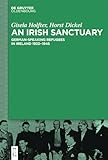An Irish Sanctuary : German-speaking Refugees in Ireland 1933–1945 / Horst Dickel, Gisela Holfter.
Material type: TextPublisher: München ; Wien : De Gruyter Oldenbourg, [2016]Copyright date: ©2017Description: 1 online resource (XII, 449 p.)Content type:
TextPublisher: München ; Wien : De Gruyter Oldenbourg, [2016]Copyright date: ©2017Description: 1 online resource (XII, 449 p.)Content type: - 9783110351446
- 9783110395754
- 9783110351453
- Austrians -- Ireland -- History -- 20th century
- Exiles -- Ireland -- History -- 20th century
- Germans -- Ireland -- History -- 20th century
- Jews -- Ireland -- History -- 20th century
- Refugees -- Ireland -- History -- 20th century
- World War, 1939-1945 -- Refugees -- Europe, German-speaking
- World War, 1939-1945 -- Refugees -- Ireland
- Emigration (1933-1945)
- Exilforschung
- Geschichte 1933-1945 / Drittes Reich
- Irland / Geschichte
- Nationalsozialismus
- HISTORY / Modern / 20th Century
- D809.I73 H76 2017
- online - DeGruyter
| Item type | Current library | Call number | URL | Status | Notes | Barcode | |
|---|---|---|---|---|---|---|---|
 eBook
eBook
|
Biblioteca "Angelicum" Pont. Univ. S.Tommaso d'Aquino Nuvola online | online - DeGruyter (Browse shelf(Opens below)) | Online access | Not for loan (Accesso limitato) | Accesso per gli utenti autorizzati / Access for authorized users | (dgr)9783110351453 |
Frontmatter -- Contents -- List of Images -- Acknowledgements -- Introduction -- Chapter 1. The Distant Option – German Refugees to Ireland, 1933–1938 -- Chapter 2. “Those days in Vienna...” -- Chapter 3. The Jews of Komotau -- Chapter 4. The German Pogrom and After -- Chapter 5. The Routes of the Refugees: Italian Passages to Ireland -- Chapter 6. The State, the Helpers and the Refugees -- Chapter 7. Uncharted Terrain – German-speaking Refugees in the Irish Provinces -- Chapter 8. Continental Dubliners -- Chapter 9. Academics in Exile -- Chapter 10. Transit Lives -- Chapter 11. Refugees Revisited -- Bibliography -- Index of Names (main text) -- Index of Places
restricted access online access with authorization star
http://purl.org/coar/access_right/c_16ec
The monograph provides the first comprehensive, detailed account of German-speaking refugees in Ireland 1933-1945 - where they came from, immigration policy towards them and how their lives turned out in Ireland and afterwards. Thanks to unprecedented access to thousands of files of the Irish Department of Justice (all still officially closed) as well as extensive archive research in Ireland, Germany, England, Austria as well as the US and numerous interviews it is possible for the first time to give an almost complete overview of how many people came, how they contributed to Ireland, how this fits in with the history of migration to Ireland and what can be learned from it.While Exile studies are a well-developed research area and have benefited from the work of research centres and archives in Germany, Austria, Great Britain and the USA (Frankfurt/M, Leipzig, Hamburg, Berlin, Innsbruck, Graz, Vienna, London and SUNY Albany and the Leo Baeck Institutes), Ireland was long neglected in this regard. Instead of the usual narrative of "no one was let in" or "only a handful came to Ireland" the authors identified more than 300 refugees through interviews and intensive research in Irish, German and Austrian archives. German-speaking exiles were the first main group of immigrants that came to the young Irish Free State from 1933 onwards and they had a considerable impact on academic, industrial and religious developments in Ireland.
Mode of access: Internet via World Wide Web.
In English.
Description based on online resource; title from PDF title page (publisher's Web site, viewed 23. Jul 2020)


